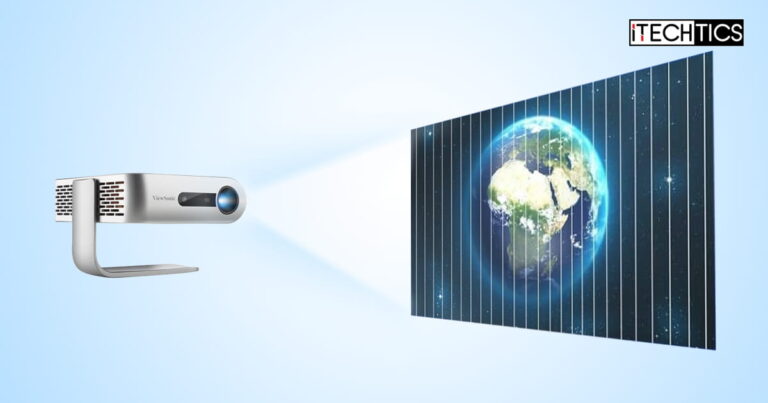A projector is a delicate piece of equipment. Slight mishandling can lead to issues with the projector, such as vertical lines on the display. Regardless if it is a Digital Light Processing (DLP) projector or an LCD projector, both can encounter an issue with vertical lines spread out all across the display.
You are likely reading this article because you have encountered this error with your projector and want to fix it, instead of having to spring for a new one.
Vertical lines in a projector display are a common issue encountered by most projector owners. In this post, we have given the solutions that will fix the problem so you can continue to use your projector with the optimal display.
Table of Contents
Cause of Vertical Lines on Projector
The vertical lines can appear due to multiple reasons in a projector’s display. Here are a few potential causes:
- Loose cables
- Overheating
- Hardware malfunction
- Magnetic interference with the projector
To address these issues, we have compiled a list of potential solutions below. Perform the following fixes to rectify the issue in the given chronological order, which starts off easy and then goes on to a more aggressive approach.
Fix Vertical Lines on Projector Display
Check Cables
The first thing you need to do is check whether the display, as well as the power cables, are firmly connected from both ends. Sometimes, a loose or faulty cable causes the signal to suddenly drop, interfering with the display quality.
The best approach is to disconnect all cables from the projector and re-insert them. Also, disconnect the cables from the other ends and reinsert them securely.
If this does not fix the issue, we also recommend that you test the cables on another projector, if one is available. This will rule out any issues with the cables.
If you find a problematic display or power cable, replace them and see if it resolves the issue.
Restart the Projector
Another thing you can do to fix the vertical lines on the display of the projector is to restart the projector itself. Shut down the device and wait for the fan to go off. Once it is completely off, unplug the projector and wait for a few seconds. Then, plug the cable back in, turn on the projector, and see if it resolves the issue.
Cool Off the Projector
Physically check if the projector is overheating. This can be checked by placing your hand on top of the projector. Slight heat dissipation is normal, but the temperature shouldn’t be extremely high. If it is, we advise you to keep the projector off while it cools off, and then check again later.
Also, visually check to see if the fan is working, or if the air vents are clogged. If you find dust accumulation in the air vents, we suggest that you perform a service on the projector, or have a professional do it for you.
Additionally, if you cannot feel the fan spinning in there, there may be an issue with your projector’s hardware. In this case, we advise you to take the projector to a trained professional who can fix the fan.
Remove Magnetic Interference
Magnetic interference is a real thing. The mechanism of projectors is easily disrupted by magnetic fields, especially if they are strong near the projector. Therefore, make sure that there is no magnetic object placed near the project.
This also includes computers and laptops, as the magnetic discs of hard drives can also be a cause for interference.
Remove all potential magnetic devices from near the projector and check if it has any effect on the vertical lines.
Disable Eco-Mode
Most modern projectors have a built-in eco mode, which is essentially a power-saving mode. When a projector enters the eco mode, it reduces power consumption, which could potentially cause issues with the projection power and cause vertical lines.
Navigate within the projector’s settings and disable the eco mode indefinitely. Then, check to see if the vertical lines are gone.
Compress the Projector
Although it may seem silly, how can it be if it works? This is perhaps the easiest (and tested) method to resolve vertical line issues with a projector.
Press down on the projector approximately 2.5-3 inches behind the projector’s lens with your thumb. Simultaneously, press at the same position from the bottom of the projector. Press the projector with caution as you do not want to do permanent damage to it. Therefore, start off with low pressure and gently increase it to normal pressure.
You will then notice that the vertical lines are changing randomly before disappearing. Once the lines go away, release the pressure off of the projector gradually.
Note that the display’s color may also change during the process. This is normal and should revert to the original color after a few seconds of letting go of the projector.
Clean the Mainboard (DMD Chip)
If you have a DLP projector, there will be a Digital Micromirror Device (DMD) chip embedded in the mainboard, also known as the motherboard. This chip is responsible for video projection and image generation in Digital Light Processing (DLP) projectors.
Often, dust and carbon accumulation on the chip connectors or the motherboard can cause interference with the display, including vertical line distortion.
Open up your projector and clean out the mainboard, as well as the DMD chip. However, we advise caution as slight mishandling could cause permanent damage to the projector.
If you do not know how to do it, we suggest that you take your projector to a professional and let them do it for you.
Closing Words
A projector is an expensive piece of equipment, and no one would want to discard an investment simply because it has a distorted image. The solutions in this article should fix the vertical lines you see on the screen.
However, issues with projectors are normal and can occur from time to time This does not mean that the vertical lines would not reappear over time. However, you can always refer to this guide, if you ever face a similar issue again.








